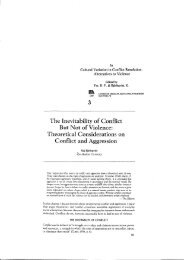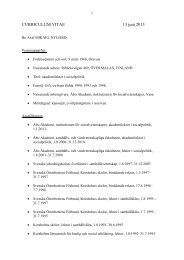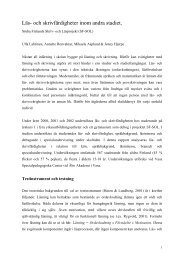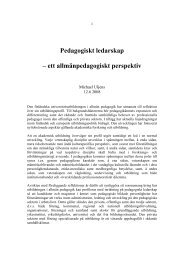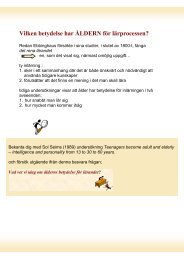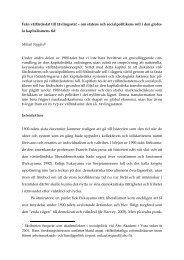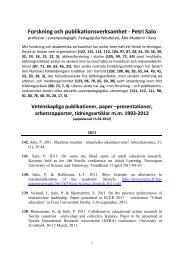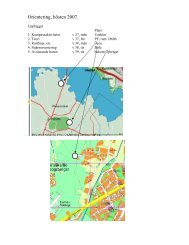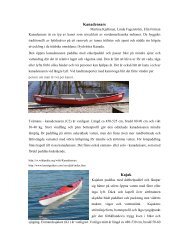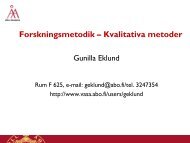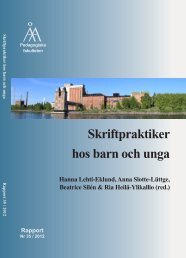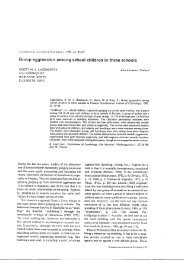Parties, Candidates and Citizens On-Line - Åbo Akademi
Parties, Candidates and Citizens On-Line - Åbo Akademi
Parties, Candidates and Citizens On-Line - Åbo Akademi
Create successful ePaper yourself
Turn your PDF publications into a flip-book with our unique Google optimized e-Paper software.
predicting c<strong>and</strong>idate website functions <strong>and</strong> sophistication showed that running for a<br />
major party was a strong significant positive predictor in both models. Additionally, the<br />
analysis revealed that being incumbent, <strong>and</strong> a competitive c<strong>and</strong>idate, were significant<br />
positive predictors of more website functions <strong>and</strong> higher sophistication.<br />
The patterns found in the third <strong>and</strong> fourth articles were also replicated in the<br />
second article focusing on several different types of political actors prior to the 2004<br />
election for European Parliament (Carlson & Str<strong>and</strong>berg 2005). All types of political<br />
actors had websites which, in general, did not make use of all possible features of the<br />
internet. They mainly focused more on providing information than engagement<br />
opportunities to the users of their websites. Specifically, though, the websites of the<br />
parties <strong>and</strong> c<strong>and</strong>idates provided a richer variety of information <strong>and</strong> more engagement<br />
features than the sites of the other political actors. A further scrutiny of the c<strong>and</strong>idates<br />
producing the campaign websites offering the most information <strong>and</strong> engagement features<br />
also gave some indirect support to the normalization theory. Compared to the c<strong>and</strong>idates<br />
producing websites with less information <strong>and</strong> engagement features, these c<strong>and</strong>idates were<br />
more often middle-aged, male, incumbents running for a major party. These socioeconomic<br />
traits are largely similar to the socio-economic patterns found regarding citizens<br />
involvement in traditional politics (Norris 2003, 39).<br />
To summarize, the findings of the articles contained in this thesis show that the<br />
Finnish actors made relatively little use of the medium’s potential. There are also few<br />
findings which indicate that the established patterns of electoral competition would be<br />
altered on-line. In the Finnish context, the on-line activity of the political actors appears<br />
to mostly be enforcing the status quo: “it seems likely that the political patterns of the real<br />
world will predominate in cyberspace” (Margolis & Resnick 2000, 73).<br />
2.1.3 Conditions influencing on-line communication of political actors<br />
Conditions potentially influential to on-line political communication have been examined<br />
in two of the thesis’ articles; the first <strong>and</strong> third (Str<strong>and</strong>berg 2006b; 2007). These articles<br />
have focused on two different types of conditions. The first article examined different<br />
types of contextual conditions while the third article focused on several actor-specific,<br />
internal, conditions. The findings concerning these different conditions are summarized<br />
<strong>and</strong> discussed in this section.<br />
Regarding the contextual conditions, the relevance of electoral settings, country<br />
development <strong>and</strong> the media environment to the normalization <strong>and</strong> equalization theories<br />
was examined in the first study. Findings indicating normalization were found to be<br />
linked to two minimum logical conditions in the national-institutional context. These<br />
were either a plurality election system alongside medium or low country development or a<br />
173



